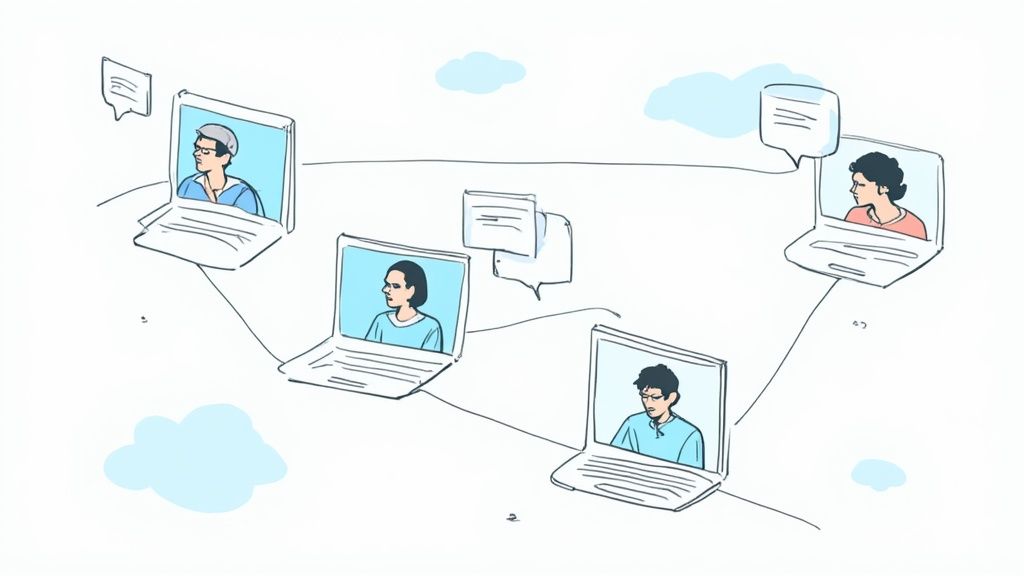Unlocking Cross Functional Team Collaboration: The Complete Guide to Building High-Performing Teams

The New Reality of Cross Functional Team Performance
Team collaboration across departments is a must for successful businesses. When marketing, sales, engineering and support teams come together on shared goals, they bring valuable perspectives and expertise that drive better results. Working collaboratively helps eliminate communication barriers between departments that often slow progress. This enables companies to better serve customers and adapt to market shifts.
The data shows clear benefits – companies using collaborative teams are 36% more likely to outperform competitors. Better communication and coordination are key factors in this improved performance. Currently, 83% of organizations have cross-functional teams to maintain competitive advantages. Learn more about cross-functional collaboration statistics.
Key Benefits of Cross-Functional Collaboration
When teams collaborate effectively across departments, it improves both operations and company culture. Here are the main advantages:
- Faster Problem Solving: Multiple experts tackle challenges from different angles for quicker solutions
- Increased Innovation: Different viewpoints spark new ideas for products and processes
- Improved Communication: Open information sharing breaks down silos between departments
- Enhanced Employee Engagement: Collaborative projects boost morale through shared ownership
- Greater Agility: Teams respond faster to market changes and customer needs
Building High-Performing Cross-Functional Teams
Creating strong cross-functional teams requires thoughtful planning and execution. Focus on these core elements:
- Clear Goals and Objectives: Ensure all team members understand the mission and desired outcomes
- Defined Roles: Clearly outline each person's responsibilities and contributions
- Open Communication: Set up communication guidelines and tools for smooth collaboration
- Strong Leadership: Choose leaders who can manage team dynamics and drive progress
- Regular Feedback: Monitor performance, provide input, and adjust course as needed
By focusing on effective cross-team collaboration and these key elements, companies can unlock better results and build stronger teams. Clear communication, defined goals, and the right leadership help teams work together successfully.
Building Communication Channels That Actually Work

Clear communication makes or breaks cross-functional teams. Basic tools like email and chat aren't enough – teams need dedicated channels that help them connect meaningfully. Understanding when to use synchronous versus asynchronous communication helps teams collaborate better and choose the right approach for each task.
Synchronous vs. Asynchronous Communication
Synchronous communication happens in real-time through video calls and in-person meetings. This works great for brainstorming sessions and quick decisions. Teams can resolve issues immediately instead of waiting for email replies. The main challenge? Scheduling across different time zones and busy calendars.
Asynchronous communication lets people contribute when it works best for them, using tools like email and shared documents. This gives team members time to think deeply and provide detailed feedback. It's especially helpful for remote workers. Plus, async channels create a record of discussions that new team members can reference later.
Overcoming Communication Barriers
Different departments often speak their own language, using specific terms and communication styles. To bridge these gaps, create a shared glossary of common terms. Encourage everyone to explain concepts in plain language and avoid jargon. This helps build shared understanding and prevents misunderstandings.
Fostering Open Dialogue and Feedback
Communication channels should do more than just pass along information – they need to support open discussion and honest feedback. Set up regular check-ins, both formal and casual. Create an environment where people feel safe sharing ideas and concerns. Tools like Supportman help by making feedback easy to give and receive, especially through platforms like Slack. When team members feel heard, they're more likely to collaborate effectively and produce better results.
Aligning Teams Around Shared Purpose and Goals
When teams from different departments work together, they need clear direction and purpose. Success comes from turning diverse skills and viewpoints into coordinated action through smart goal-setting and vision alignment. Let's explore practical ways to set objectives that resonate across teams while respecting each group's expertise.
Defining Shared Objectives
The foundation of effective cross-functional collaboration is having clear, shared goals. These should follow the SMART framework – being Specific, Measurable, Achievable, Relevant, and Time-bound. Rather than saying "improve customer satisfaction," make it concrete: "increase customer satisfaction scores by 15% within the next quarter." This clarity helps everyone understand both the target and how success will be measured.
Building a Framework for Accountability
After setting goals, teams need a clear accountability structure. This means helping each person understand their role and how their work affects the bigger picture. Key components include:
- Assigning specific responsibilities
- Setting clear deadlines
- Establishing regular check-ins
- Using tools like Supportman to track progress and share updates through platforms like Slack
When teams can see how their efforts directly impact customer satisfaction, it builds shared ownership of outcomes.
Balancing Competing Priorities
Different departments often have competing needs – marketing may focus on brand awareness while sales prioritizes leads. Success requires:
- Open discussion of each team's priorities
- Finding common ground with overall objectives
- Making fair compromises
- Developing solutions that benefit multiple groups
Maintaining Focus and Measuring Progress
Keeping teams aligned needs ongoing effort through:
- Regular team meetings
- Progress updates
- Feedback sessions
- Data tracking and metrics
- Celebrating wins together
- Recognizing individual contributions
Consistent evaluation and adjustment help maximize cross-functional collaboration. The key is maintaining open communication while tracking measurable results, allowing teams to stay motivated and make improvements when needed.
Transforming Collaboration Challenges Into Opportunities

Working across different teams and departments brings many benefits, but also comes with real challenges. Success depends on how well teams handle these obstacles and find ways to grow and improve together.
Managing Conflicting Priorities
One of the biggest hurdles teams face is dealing with competing goals and priorities. Marketing teams often focus on brand awareness while sales teams chase revenue targets. These different aims can create tension if not handled well. The key is open communication – teams need to clearly share their priorities and work to find common objectives that help the whole company succeed.
Bridging Cultural Differences and Work Styles
Each department has its own unique culture and approach to work. Some value strict processes while others prefer flexibility and creativity. These differences can lead to miscommunication and make teamwork harder. Success requires mutual understanding and respect between teams. This might mean setting up shared communication guidelines or being more adaptable in how work gets done.
Turning Friction Points into Innovation
While differences between teams can be challenging, they're also opportunities for fresh thinking and better solutions. Different viewpoints often spark new ideas and approaches. Teams need to create an environment where healthy debate is welcomed and people feel safe sharing different opinions. For example, when engineering and design teams disagree, it can lead to products that work better for users.
Building Team Cohesion and Resilience
Strong relationships form the foundation of successful teams. This is especially important for cross-functional groups where people may not know each other well. Team activities, social events and casual chats help build these bonds and create community. These connections help teams stay strong during tough times and keep momentum going. Tools like Supportman can strengthen team bonds by making communication easier on platforms like Slack. This lets teams celebrate wins and address issues openly, building resilience for future challenges.
Maximizing Impact Through Strategic Technology Integration

Picking the right tools matters immensely for teams working across departments. Using too many different systems often leads to confusion and slows teams down. Let's explore how to choose and implement technology that genuinely helps teams collaborate better.
Essential Features for Diverse Team Needs
Different teams need different tools – what works for marketing may not work for customer support. Here are the key capabilities to look for when building your tech stack:
- Central Communication Hub: One place for messages, files and updates keeps everyone connected. Slack works well as a main communication platform.
- Project Management Tools: Keep work organized with task assignments and deadlines. Good project management software helps track who's doing what.
- Quick Feedback Systems: Enable fast responses and smooth decision-making. For example, Supportman connects customer feedback directly to Slack for immediate team insights.
- Connected Tools: Make sure data flows smoothly between systems to cut down manual work. Link your CRM to marketing tools to automate follow-ups.
- Security Controls: Protect sensitive info while giving the right access to team members. This matters most with customer data and company secrets.
Implementing Technology Effectively
Having good tools isn't enough – you need smart rollout and adoption. Here's what works:
- Step-by-Step Launch: Add new tools gradually with proper training. This helps teams adapt without disrupting ongoing work.
- Regular Check-Ins: Get input from users to ensure tools meet their needs. Make changes based on how people actually use them.
- Clear Rules: Create simple guidelines about which tools to use when. This prevents confusion and helps people use tools consistently.
- Ongoing Help: Keep training and supporting teams to get full value from the technology. Help them troubleshoot issues quickly.
Driving Adoption Across Teams
Getting different teams comfortable with new tools takes work. Try these approaches:
- Show Clear Value: Explain specifically how the tools will make work easier and improve results. Focus on practical daily benefits.
- Find Advocates: Pick enthusiastic team members to help others learn the tools. These champions can provide peer support.
- Make it Fun: Consider friendly competitions or rewards for using new tools well. This can boost early adoption.
- Keep Improving: Review how tools are working and adjust based on feedback and usage data. This keeps technology relevant.
Building connected teams starts with smart tech choices and strong adoption plans. When done right, it brings teams closer together and helps them achieve more. The right tools, like Supportman, can significantly improve both team collaboration and customer happiness.
Measuring Success and Driving Continuous Improvement

Teams need clear ways to track their progress and identify areas of improvement. This starts with looking at how individual members contribute and measuring the team's overall impact. Let's look at proven methods that successful teams use to gather feedback, celebrate wins, and grow together.
Setting Up Clear Feedback Systems
Teams thrive when feedback flows freely between members. Quick weekly check-ins help address immediate concerns, while monthly reviews examine broader progress. This openness helps team members feel comfortable sharing their thoughts and leads to better outcomes. The key is creating an environment where everyone's voice matters.
Simple tools can make feedback easier. For example, integrating Supportman with Slack helps teams share ideas quickly. When feedback happens in real-time, teams can solve problems faster.
Recognizing Team Achievements
Every win matters – both small daily victories and major milestones. Simple praise in team meetings or structured recognition programs can make a big difference. The key is making celebrations meaningful and tied to real accomplishments. When teams celebrate together, it builds unity and motivates everyone to keep collaborating.
Finding Ways to Improve
While celebrating success matters, teams also need to identify what could work better. Regular performance reviews help spot areas to refine processes. Teams should look at things like project timelines, how they communicate, and their decision-making approach. This helps teams stay effective as needs change.
Tracking Performance That Matters
Key Performance Indicators (KPIs) give teams concrete data to measure progress. Choose metrics that connect directly to team goals rather than tracking too many numbers. For example, if you want happier customers, focus on satisfaction scores and response times. This focused approach helps teams make smart adjustments based on real data.
Making Changes Based on Results
Good teams adjust their methods based on what works. They might update how they communicate, change workflows, or try new tools. If feedback shows communication gaps, teams can set new guidelines or use tools like Supportman to improve clarity. This focus on steady improvement helps teams stay strong as conditions change.
Want better team feedback? Try Supportman's real-time integration. Start your free trial today!
What to do next
Whenever you're ready, here's three ways we can help you scale your support org:
- Claim your free Support Manager Handbook. It's a free 30+ page guide filled with strategies, tactics, and best practices for scaling your support org. Download it here.
- Subscribe to our Support Ops newsletter to get the latest updates here.
- Set up Internal Documentation with Tettra to start automatically answering the questions you get in Slack. Here's how.

